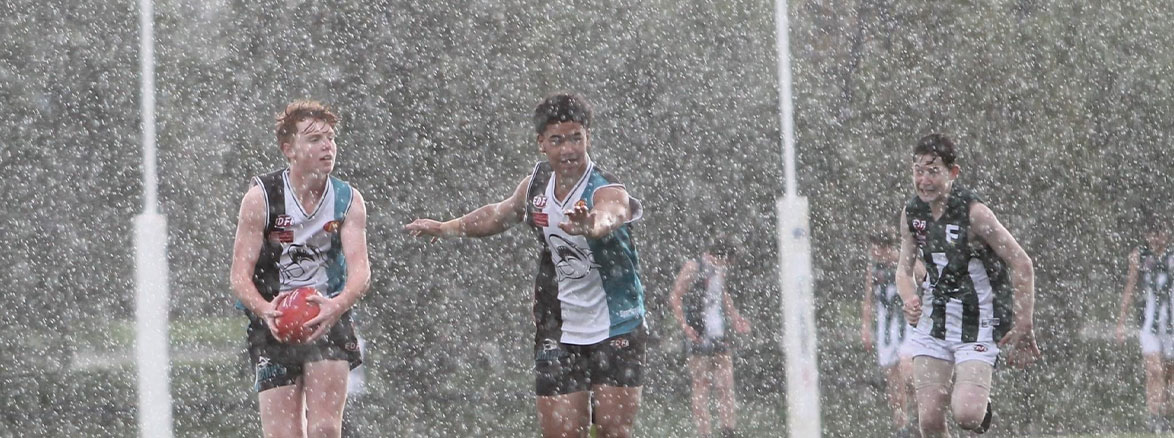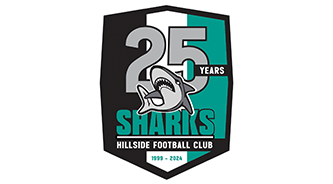Rules and Policies
The Hillside Football Club (Weather Policy)
Weather Policy
EDFL EXTREME WEATHER POLICY
Extreme weather and environmental factors can affect the playing of Australian
Football. This policy sets out the approach that the EDFL adopts when assessing
extreme weather and environmental conditions at training and during matches.
Heat
Heat stress and injury can lead to impaired player performance and physical distress
including dizziness, headaches, collapsing and illness. In its extreme form it can be
life threatening. To prevent heat stress, careful planning and preparation is required.
EDFL Matches
The EDFL takes the health and wellbeing of its players, coaches, officials and
volunteers very seriously and the following information outlines the elements of the
EDFL’s strategy to prevent heat stress in match conditions:
- When temperatures are forecast above 32°C at the scheduled commencement of the match (as per www.bom.gov.au or BOM App), clubs and umpires will be notified via the EDFL Website by no later than 5pm on the Thursday that the EDFL Extreme Weather Policy may be implemented.
- If required, a formal announcement will be made on the EDFL Website between 9.30am and 11.00am on the day of the match advising clubs and umpires that the EDFL Extreme Weather Policy is to be adhered to and the following changes shall be applied based on the below tables:

Men’s Seniors
| EDFL Rules | Extreme Weather Policy Changes | |
|---|---|---|
| Quarter Lengths | 20 Minutes plus time on | 15 Minutes plus time on |
| Quarter Time Break | 4 Minutes | 10 Minutes |
| Half Time Break | 15 Minutes | 20 Minutes |
| Three Quarter Time Break | 5 Minutes | 10 Minutes |
| Number of water carrier | 2 | Up to 4 Given then supply water to umpires |
If the temperature is equal to, or greater than 32°C at the scheduled commencement of the match:
- The teams and umpires are able to leave the field during the breaks if so desired
If the temperature is equal to, or greater than 36°C at the scheduled commencement
of the match:
- The match shall be delayed for up to 30 minutes. If the temperature has not dropped below 36°C, the match shall then be cancelled.
- If, during the course of an EDFL match, the temperature rises to above 36°C then the match shall be suspended for up to 30 minutes. If the temperature has not dropped below 36°C, the match shall then be cancelled.
- If the match is cancelled and/or unable to commence due to excessive heat conditions (as determined by the EDFL Extreme Weather Policy), EDFL Football Operations staff shall determine how the premiership points for the match will be allocated in accordance with the AFL Laws of the Game
The umpires will be responsible for making the decision to delay or cancel a game at a quarter break with the team managers responsible for notifying umpires if the temperatures rises to 36°C or above during the course of play.
All temperature readings will be from the www.bom.gov.au or BOM App and taken from the location of the match.
Training
All Clubs competing in a competition administered by the EDFL should monitor environmental factors such as extreme heat at any Australian Football training session conducted by the Club. The Club should assess the heat stress risk by
reviewing information provided by the Bureau of Meteorology. Heat stress
management strategies should also be applied at all training sessions administered
by the Club.
The following general guidelines should be followed:
Clubs should:
- Use cooling aids if available – ice vests, spray bottles, sponges, fans and shade;
- Use a Club official to be delegated the primary responsibility of monitoring and manage players for heat stress issues as they arise at training;
- Provide adequate fluids in appropriate bottles;
- Ensure trainers are fit enough to access as many players as possible during training;
- Coordinate training times outside extreme conditions; and
- Provide facilities for player cooling – shade, air conditioning, sprays and fans whether training or playing.
- No training should be conducted in temperatures above 36°C.
Lightning
In the absence of specific information from weather radar, a lightning location system, or a specialised warning device then the 30/30 Safety Guideline should be used. According to the 30/30 Safety Guideline, when lightning is considered to be a possible or actual threat to an Australian Football Match the following procedures are applicable:
- The observation of approaching storm clouds, the first flash of lightning or clap of thunder, no matter how far away should heighten lightning awareness. The level of risk depends on one’s location (direction and distance) relative to the storm cell and the direction in which the storm system is traveling.
- A simple method of determining the distance to the storm cell is to measure the time elapsed from when the lightning flash is observed and when the associated clap of thunder is heard.
- Light travels faster than sound. Assuming that the light from the flash reaches the observer instantaneously, and knowing that sound takes approximately three (3) seconds to travel one (1) kilometre, the distance c an be determined by using the following rule:
Distance (in Km) = Time from observing the flash to hearing thunder (in 3
seconds)
The first part of the “30/30” rule is a guide to the postponement or suspension of activities. Most experts agree that the
accepted “safe‟ distance from lightning is greater than 10km. This means that as the time interval between observing the flash and hearing the thunder approaches 30 seconds, all those in
exposed areas should be seeking or already inside safe shelters. A storm cell with lightning activity within 10km constitutes a threat. The second part of the 30/30 rule provides the criteria for the resumption of activity which is applicable to decisions made with BOM access as well. Here, it is recommended that people wait a minimum of 30 minutes after the last sighting
of lightning or sound of thunder. This figure is based on the
observation that the typical storm moves at about 40km/h. Thus, waiting 30 minutes allows the thunderstorm to be about 20km away, minimising the likelihood of a nearby lightning strike.
Process:
- If an EDFL umpire believes that there is any danger posed by lightning during or prior to the commencement of an EDFL match then they shall suspend or not commence the match.
- A member of the umpiring panel shall inform the two clubs of the decision to suspend or not commence the match.
- A member of the umpiring panel shall contact the EDFL Umpire Manager (or delegate) and/or an EDFL Football Operations Staff Member to inform them of the extreme weather situation.
- The umpire shall then contact the EDFL Umpire Manager (or delegate) and/or an EDFL Football Operations Staff Member when there has been no consecutive thunder for 30 seconds.
- This will then commence the 30-minute period that must be served before any decision to recommence an EDFL match is made.
- The EDFL Football Operations department may instruct the
umpires to cancel the remainder of the game, shorten quarters (if the match is to be recommenced) or complete the full
remainder of the match depending on the circumstances of the match.
- A general guide will be that a match can be delayed by up to 60 minutes before being cancelled providing that no other factors are involved which may limit the ability for the match to be completed (this may include, but are not limited to, inadequate lighting, games scheduled following the match or unsafe conditions).
- If the match is cancelled and/or unable to commence due to lightning (as determined by the EDFL Extreme Weather Policy), EDFL Football Operations staff shall determine how the premiership points for the match shall be allocated in accordance with the AFL Laws of the Game.
Training
- If a lightning threat emerges, the nominated Club Official must contact all relevant coaching, rehabilitation and training staff and provide updates on a regular basis.
- A decision to delay, suspend or resume training should be made in consultation with relevant coaching and administration staff and a conservative approach should be taken
- If players are training when the lightning threat becomes real then they should leave the training venue immediately and take shelter inside a building or metal framed car. They should not shelter under or near trees.
- Once the storm’s path has been reassessed as safe, there must be a minimum of 30 minutes elapsed before returning to training.
- When there is no access to the BOM, the “30/30” rule serves as a guide for the suspension and subsequent resumption of activities.
Cancelled Matches
- f half or more than half of the games are cancelled or abandoned due to extreme weather in the same grade and division, the round will be declared void and no premiership points, percentages, goalkickers or best and fairest votes will be awarded or applied for that round. Matches will count towards finals qualification so long as teams submit their team sheet on the day of the match. Any reportable offence or blue card will proceed according to the usual process.
- If a match does not reach the half-time break before it is cancelled, the match will be declared a draw and no best and fairest votes will be awarded for that match.
